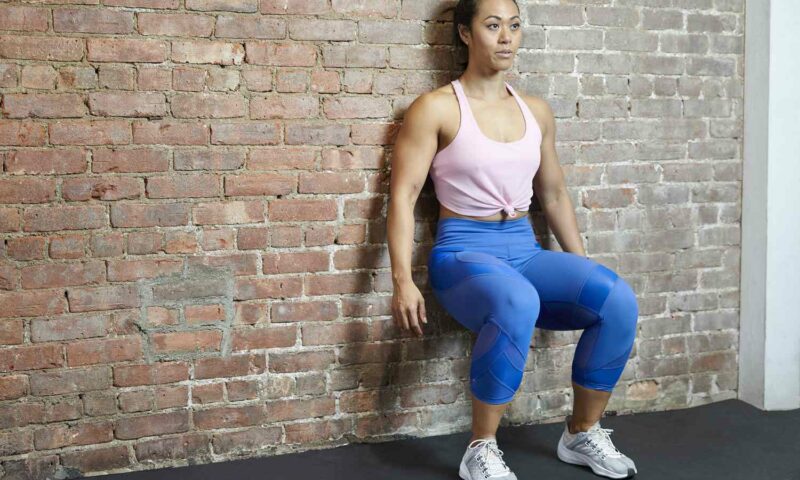(Pictured: A wall sit–back against a wall, knees bent for at least 30 seconds–does wonders for blood pressure, according to cardiovascular experts.
Want to lower your blood pressure with the help of exercise? It doesn’t require running on a treadmill or pumping iron. Instead, static isometric exercises like wall sits (also known as wall squats) and planks — which engage muscles without movement — are best, according to analysis published in the British Journal of Sports Medicine that includes aerobic activity, weight training and high-intensity interval training.
Of the exercises that were analyzed, the wall sit was the most effective, the study found.
Doctors recommend heart-healthy activities like walking, running and cycling as their top choices for patients with hypertension. But isometric exercises are almost twice as effective at lowering blood pressure compared with just doing cardio, said Jamie O’Driscoll, a researcher in cardiovascular physiology at Christ Canterbury Church University.
To perform a static isometric exercise, you hold your body in one position until your muscles tire. Examples include wall sits, planks and side planks, glute bridges and heel raises.
Isometric exercises are a great option for older adults because they are low-impact and don’t require any special equipment, said Meredith Dobrosielski, an exercise physiologist at Johns Hopkins University.
“It’s an easily accessible form of exercise that you can do pretty much anywhere,” Dobrosielski said. “You don’t need to go to a gym or spend a lot of time doing it. You just need your body.”
Ready to try a wall sit yourself? Start with these steps:
- Stand with your back against a wall, feet hip-width apart, and place your feet one or two steps away from the wall. Keep your arms at your sides.
- Keeping your back flat against the wall, bend your knees until you hit an angle that you can hold for at least 30 seconds. (Your thighs don’t have to be at 90 degrees).
- Hold the position by pressing your back against the wall.
- Relax the pose by standing. Repeat for a total of four wall sits, with short breaks in between.
More static exercises to try.
- Glute bridge.Strengthens the glutes, hips, hamstrings and core. Lie on your back with your arms at your sides, knees bent, and feet planted on the ground. Push your heels into the ground and tuck your tailbone. Then squeeze your glutes, raise your hips toward the ceiling and hold.
- Wall plank. Works the shoulders, arms and core. Place your hands on a wall at shoulder height. Then take a step back, tucking in your glutes as your body weight shifts into your arms. Focus on your core muscles by thinking of pulling your belly button into your spine. For a greater challenge, place your elbows and forearms on the wall.
- Heel raise. Strengthens calf muscles, improves ankle stability and boosts overall lower body strength. Stand with your feet shoulder-width apart, keeping a chair or wall in front of you for balance. Raise your heels off the ground and hold.
Source: AARP
